Design and description
The four ships of the Frolic class were repeats of the preceding Beacon class despite being begun four years later. [1] The ships were 155 feet (47.2 m) long between perpendiculars and had a beam of 25 feet (7.6 m). Forward, the ships had a draught of 7 feet 9 inches (2.4 m), but aft they drew 9 ft 6 in (2.9 m). They displaced 610 long tons (620 t) as built and had a burthen of 462 tons. [2] The depth of hold was 11 feet (3.4 m) and the hull was subdivided by watertight bulkheads. [3] Their crew consisted of 80 officers and enlisted men. [2]
The supply of engines from the old Crimean War gunboats had been exhausted by that time and they were given brand-new engines. [1] Unlike their half sisters, these ships received new compound-expansion trunk steam engines from John Penn and Sons. Each engine powered a single 6-foot (1.8 m) propeller. The engines produced between 715 and 896 indicated horsepower (533 and 668 kW) which gave the ships a maximum speed between 10 and 11 knots (19 and 20 km/h; 12 and 13 mph). The new engines proved to be more powerful than those used in the Beacons, but they were as uneconomical as the simple steam engines used in the older ships and fell from favour as a result. Three cylindrical boilers provided steam to the engines at a working pressure of 80 psi (552 kPa ; 6 kgf/cm2 ). [4] The ships carried 80 long tons (81 t) of coal which gave them a range of 880 nmi (1,630 km; 1,010 mi) at 10 knots. [2]
The hull shape of the Frolics was identical to that of their predecessors and they had a very full hull shape with squared-off bilges and a flat bottom. Admiral G. A. Ballard commented that they were built "along the lines of an extremely elongated packing crate." [5] This made them steady gun platforms and gave them quite a bit of buoyancy. If they ran aground, this shape allowed them to be pulled off easily and they remained upright if stranded by a receding tide. However, this hull shape made their steering erratic at low speeds or in a following sea and they made a large amount of leeway in a strong side breeze. [5]
The class was barque rigged and their best speed under sail alone was over 12 knots (22 km/h; 14 mph) if running before the wind, despite the drag of the propellers, which could neither be hoisted out of the water, nor feathered. In a headwind, Ballard described them as "quite unmanageable under sail alone" because of their shallow draft and flat bottom. Their funnels were hinged to lower horizontally to reduce wind resistance while under sail. A poop deck was added in between commissions, but this was the only major structural change made during their careers. [6]
The ships were initially armed with a mix of 7-inch and 64-pounder 56 cwt [Note 1] rifled muzzle-loading guns and a pair of 20-pounder rifled breechloading guns. The 7-inch (178 mm) and 64-pounder guns were mounted on the centreline as pivot guns while the two 20-pounder guns were mounted at the bow and stern as chase guns. [7] The 16-calibre 7-inch gun weighed 6.5 long tons (6.6 t) and fired a 112-pound (50.8 kg) shell. It was credited with the nominal ability to penetrate 7.7-inch (196 mm) armour. [8] A lighter, 4.5-long-ton (4.6 t), 7-inch gun developed in the 1870s replaced the heavier gun in Frolic and it replaced both heavy guns in Rifleman. [9]
Service
These ships were primarily designed for service in Southeast Asian waters, including the rivers, and Frolic and Kestrel spent at least one commission there. Their duties included protecting British lives and property and fighting pirates. Another major deployment area was the Gulf of Guinea in West Africa where Frolic and Rifleman served part of one or more commissions. Frolic, Ready, and Rifleman served at least one commission off the south-east coast of South America. Kestrel, Ready, and Rifleman each made one or more deployment to the East Indies Station where they helped to suppress the slave trade between East Africa and the Persian Gulf. [10] At the beginning of the Anglo-Egyptian War of 1882, Ready seized the assets of the Suez Canal Company, including its dredgers. At the end of 1873, Kestrel was on the China Station, Ready off South America, and Rifleman in the East Indies. A few months later, Frolic was one of the ships that blockaded the mouth of the Klang River in Malaysia in an attempt to suppress piracy supported by the local sultan. Together with the survey ship Nassau, Rifleman helped to suppress a rebellion in Mombasa against the British-supported Sultan of Zanzibar in 1875. [11]
All four ships were placed in reserve in the mid-1880s [12] and Kestrel and Rifleman were sold in 1888 and 1890 respectively. [2] Frolic became a training ship for the Royal Navy Volunteer Reserve in 1888 before being assigned to the Coastguard in 1893 as Watch Vessel W.V.30 and later W.V.41. She was sold for scrap on 7 April 1908. [13] Ready was converted into a tank vessel in 1894, renamed Drudge in October 1916 [2] and sold in Bermuda on 25 February 1920. [13] Her new owners converted her to a lighter and she carried the winch that hoisted William Beebe's bathysphere up and down in 1930. [14] Her remains, positively identified by J. M. Greeley during an underwater archaeology field school held by East Carolina University in 1998, lie on the north side of St. George's Harbor Bermuda beside a former coaling wharf at Latitude 32°22'50.23"N and Longitude 64°40'14.68"W. The hull can be seen on Google Earth just below the water's surface on a north-south orientation with the bow towards the shoreline and the stern in deeper water. In 1998 the semicircular tracks for the gun mounts were still visible in what remained of the deck. The mounts for the boilers remained in the midsection and the outline of the boilers and funnel shaft were clearly visible on the aft side of the forward bulkhead.
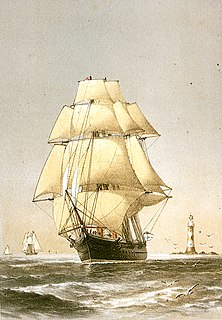
HMS Active was a Volage-class corvette built for the Royal Navy in the late 1860s. Launched in 1869, she entered service in 1873, and was the Commodore's ship on the Cape of Good Hope and West Africa Station. Her crew served ashore in both the Third Anglo-Ashanti and Zulu Wars. From 1885 to 1898, the ship was the flagship of the Training Squadron. Active was sold for scrap in 1906.

The Osprey class was a Royal Navy class of screw-driven sloops built between 1874 and 1877. Nine additional ships were built to a revised design, the Doterel-class sloop. They were the first class of ship in the Royal Navy to use glass scuttles.

The Mariner class was a class of six 8-gun gunvessels built for the Royal Navy between 1883 and 1888. Four were built in the Naval Dockard at Devonport, and two elsewhere; the Acorn was built by contract at Jacobs Pill on the Pembroke River, while the Melita was built in the Malta Dockyard, the only substantial ship of the Royal Navy ever to be built in the island.
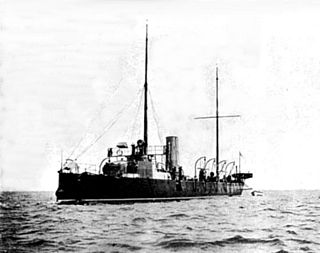
HMS Rattlesnake was a unique design of torpedo gunboat of the Royal Navy. A result of the Russian war scare of 1885, she was designed by Nathaniel Barnaby that year and built by Laird Brothers, of Birkenhead. Quickly made obsolete by the new torpedo boat destroyers, she became an experimental submarine target ship in 1906, and was sold in 1910.
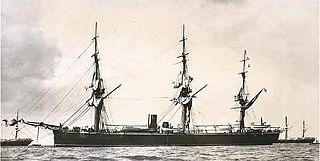
HMS Rover was an 18-gun iron screw corvette built for the Royal Navy in the 1870s, the sole ship of her class. The ship was initially assigned to the North America and West Indies Station until she returned home in 1879. She was transferred to the Training Squadron when it formed in 1885. Rover was not really suitable for such a role and she was placed in reserve four years later and then sold for scrap in 1893.

The Condor-class gunvessel was a class of four Royal Navy composite gunvessels of 3 guns, built between 1876 and 1877. They were all hulked or sold before 1893, giving them an active life of less than 15 years.

HMS Druid was a Briton-class wooden screw corvette built for the Royal Navy in the late 1860s. She spent her service life overseas on the Cape of Good Hope and North America and West Indies Stations and was sold for scrap in 1886.
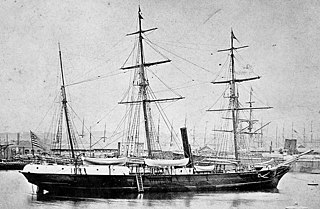
The Philomel-class gunvessel was a class of wooden-hulled screw-driven second-class gunvessels built for the Royal Navy between 1859 and 1867, of which 26 were ordered but only 20 completed. They had a mixed history, with some serving for as little as 5 years, and others surviving into the 1880s. Two of the class were sold and used as Arctic exploration vessels, both eventually being lost in the ice.

HMS Dragon was a Doterel-class sloop of the Royal Navy, built at Devonport Dockyard and launched on 30 May 1878. She served in the East Indies, including the Anglo-Egyptian War of 1882, and the suppression of slavery. She was sold for breaking in 1892.

The Volage class was a group of two screw corvettes built for the Royal Navy in the late 1860s. Both ships spent the bulk of their active service abroad. Volage spent most of her first commission assigned to the Detached or Flying Squadron circumnavigating the world and then carried a party of astronomers to the Kerguelen Islands to observe the Transit of Venus in 1874. The ship was then assigned as the senior officer's ship in South American waters until she was transferred to the Training Squadron during the 1880s.

HMS Volage was a Volage-class corvette built for the Royal Navy in the late 1860s. She spent most of her first commission assigned to the Flying Squadron circumnavigating the world and later carried a party of astronomers to the Kerguelen Islands to observe the transit of Venus in 1874. The ship was then assigned as the senior officer's ship in South American waters until she was transferred to the Training Squadron during the 1880s. Volage was paid off in 1899 and sold for scrap in 1904.
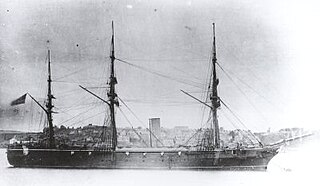
HMS Amethyst was the lead ship of the Amethyst-class corvettes built for the Royal Navy in the early 1870s. She participated in the Third Anglo-Ashanti War in 1873 before serving as the senior officer's ship for the South American side of the South Atlantic. The ship was transferred to the Pacific Station in 1875 and fought in the Battle of Pacocha against the rebellious Peruvian ironclad warship Huáscar two years later. This made her the only British wooden sailing ship ever to fight an armoured opponent. After a lengthy refit, Amethyst again served as the senior officer's ship on the South American station from 1882 to 1885. She was sold for scrap two years later.
The Briton class was a group of three wooden screw corvettes built for the Royal Navy in the late 1860s. All three ships of the class only served overseas during their brief service lives. Between them, they were assigned to the China, East Indies, African, North American, and the Pacific Stations. All three were regarded as obsolete 15 years after they were completed, and they were sold in 1886–87.
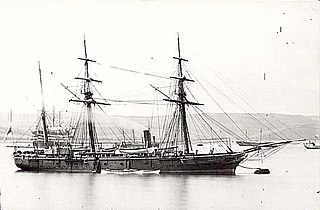
The Arab-class gunvessels were a pair of composite gunboats built for the Royal Navy in the mid-1870s.

The Beacon-class gunvessels were a class of composite gunboats built for the Royal Navy in the late 1860s. They were the first warships of the Royal Navy expressly designed to use the engines of an older class of ships with a different hull shape. They were generally deployed overseas to the China, East Indies, West Africa, Pacific, North America and West Indies Stations. In addition to showing the flag, the ships fought pirates and suppressed the slave trade in East and West Africa. As their engines wore out in the mid-1880s, they were mostly retired and scrapped by the end of the decade. A few survived into the early 1900s as they were modified for harbour service before being sold or scrapped.

The Banterer-class gunboat was a class of eleven gunboats mounting two 6-inch and two 4-inch guns, built for the Royal Navy between 1880 and 1892.

The Albacore-class gunboat, also known as "Crimean gunboat", was a class of 98 gunboats built for the Royal Navy in 1855 and 1856 for use in the 1853-1856 Crimean War. The design of the class, by W. H. Walker, was approved on 18 April 1855. The first vessels were ordered the same day, and 48 were on order by July; a second batch, which included Surly, were ordered in early October.

The Bramble-class gunboat was a class of four gunboats mounting six 4-inch guns, built for the Royal Navy in 1886. In 1887 the first three were reclassified as gunvessels.

On the 26th of March 1846, two vessels were ordered from Deptford Dockyard as Rifleman designed gunvessels named Archer and Parthian. However, on 9 September 1846 the orders for both vessels were suspended prior to the vessels being laid down. On the 25th of April 1847 two vessels were ordered to the improved Rattler type screw sloops as designed by John Edye of the Surveyor's Department from Deptford Dockyard. The first vessel, Archer may have been the change of the build from the Rifleman type to the sloop design. The second vessel, Wasp, appears to be a new vessel as the build for the Parthian remained on the books at Deptford until June 1849 when it was cancelled. Archer received the machinery from the gunvessel Rifleman which resulted in an increase of speed over Wasp. Wasp’s hull was sheathed in Muntz metal to retard marine growth. Their armament would increase from 12 to 15 guns over their careers. Both vessels would participate in the Russian War of 1854 - 1855. Both would be broken by 1869.
















